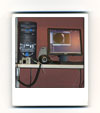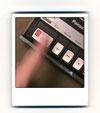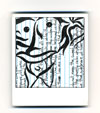in the Composition Classroom
Debra Journet, Tabetha Adkins, Chris Alexander, Patrick Corbett, Ryan Trauman
University of Louisville
This essay describes and documents acts of “reflection” in a seminar on digital media and composition, offered as part of the Ph.D. in Rhetoric and Composition at the University of Louisville. Four of the authors (Adkins, Alexander, Corbett, Trauman) were participants in the seminar; the fifth author (Journet) was the instructor. One of the class requirements was to construct daily “reflections” using any media or modality: e.g., audio, video, pictures, alphabetic text. (For more on the nature of this assignment, click Journet.) In this essay, we present excerpts from our reflections and consider the kinds of analytical or critical work these reflections represent. We are all composition teachers, and during the seminar our overall focus was how to move the work we were doing into our own undergraduate teaching. Our reflections are thus very much centered on the role of digital media in the composition classroom, and we accordingly pay particular attention to how the theory and research we were reading and the technical knowledge we were gaining would enhance pedagogical practice. At the same time, we were also students, and our work thus also documents how reflection contributed to the acts of learning we engaged in as we composed in digital media.
We are guided by an awareness of the general value of reflection in the action of learning and teaching in composition, as well as its more specific contributions to computers and composition (Hillocks, Schon, Yancey; see Irvin for a useful summary). Reflection, in our own understanding and practice, offers writers an opportunity to become aware of their processes of learning and composing, to make connections between new and familiar experiences and information, to experiment and try out new ideas and approaches. However, though we were all experienced producers and evaluators of written reflections, we were unfamiliar with reflections in modes other than alphabetic text. What we discovered as we composed multimodal reflections was that modality changed the nature of reflection. In our experience, reflection, particularly in video and audio modes, made us
- pay new attention to experimentation and “play.” In particular, we began to see how reflective actions can encourage students to confront and conquer anxieties relating to voice, technological ability, or presentation of self. In turn, as teachers, we realized how our own responses to new learning experiences provide an opportunity to understand the apprehensions of many first-year students who enter our classrooms.
- understand better the value of pauses and missteps embedded in our original daily reflections. As we revisited these texts, we came to recognize their potential for offering a more direct interaction between processes of creation and reflection and a perspective on the composer/audience relationship different from that of traditional print text.
- explore reasons for resistance to the genre of “reflective" composing. Multimodality, that is, allowed us to see reflection anew, providing ways to bring together threads of seemingly disparate practices. It pushed us to focus on the process of reflection without necessarily attending to the textual characteristics of the reflection genre as it is typically performed in the classroom.
- foreground the difference between conceptualizing a text and producing it. Multimodal reflections were especially helpful in pushing us to investigate the conceptual gap created by the differences between a text's modes of communication and our modes of composition as authors.
In this multimodal essay, we “reflect” on our acts of multimodal reflection. In particular, we are interested in the following questions: 1. What does multimodal reflection look and sound like and how does it differ from written reflection? 2. What is the value of multimodal reflection? 3. What are the limitations of (or what gets left out of) multimodal reflection? In a series of projects (which you can access by clicking on the author's name) we present an overview of the assignment and four video or audio texts in which we explore the kinds of learning—pedagogical, theoretical, and practical—that these reflections fostered.
We believe our reflections both elicited and documented learning . That is, reflections did not simply provide another window onto a kind of learning that would have happened anyway; nor were they just intermediate stages toward a more finished final product. Rather, in the action of reflection we were able to engage in activities of play, discovery, and creativity—activities that fostered a more flexible and robust understanding of how modality shapes meaning.




